taken with iphone and
iPhone Photography
Skip to content, navigation.

Today, many streaming radio stations are observing a day of silence to highlight the impending change in licensing fees that will force many of them off the air. A visitor to Pandora sees a letter from CEO Tim Westergren saying:
I'm sorry to say that today Pandora, along with most Internet radio sites, is going off the air in observance of a Day Of Silence. We are doing this to bring to your attention a disastrous turn of events that threatens the existence of Pandora and all of internet radio. We need your help.
Likewise, a visitor to Radio Paradise will hear only environmental sounds (birds chirping, frogs croaking, .. it is actually quite pleasant).
Some
notable participants in today's event are (according to the SaveNetRadio
website): Pandora, RadioParadise, RadioIo Yahoo!, Live365, Rhapsody,
MTV Online, AccuRadio, KCRW and about 100 others. Notably absent
is Last.fm - and they tell why in their recent blog post: Make some noise.
Most interesting of all is the comment thread on that blog post where
last.fm execs and staffers defend last.fm's position against the
disgruntled.
 If you are one of the lucky ones to have a paper accepted to ISMIR 2007 -
remember that the camera-ready version is due this Friday, June
29. So if you plan to be waiting in line at an Apple store on
Friday, you should plan ahead. Note that the latex/word templates
have been modified slightly, so even if you think you have no changes to
make, you will have to generate a new version with the updated
template. And of course, you need to register for the conference by
Friday ... so make sure you find someone with a credit card.
If you are one of the lucky ones to have a paper accepted to ISMIR 2007 -
remember that the camera-ready version is due this Friday, June
29. So if you plan to be waiting in line at an Apple store on
Friday, you should plan ahead. Note that the latex/word templates
have been modified slightly, so even if you think you have no changes to
make, you will have to generate a new version with the updated
template. And of course, you need to register for the conference by
Friday ... so make sure you find someone with a credit card.
While registering, make note of the tutorials that are being held on the Sunday before the conference. In particular Oscar Celma, and I will be present a 3-hour tutorial on music recommendation. I'm really excited about this, it should be fun. Here's the abstract:
As the world of online music grows, music recommendation systems become an increasingly important way for music listeners to discover new music. Commercial recommenders such as last.fm and Pandora have enjoyed commercial and critical success. But how well do these systems really work? How good are the recommendations? How far into the ‘long tail’ do these recommenders reach? In this tutorial we look at the current state-of-the-art in music recommendation. We examine current commercial and research systems, focusing on the advantages and the disadvantages of the various recommendation strategies. We look at some of the challenges in building music recommenders and we explore some of the ways that MIR techniques can be used to improve future recommenders.
There are some other very interesting tutorials as well. I'm particularly interested in the tutorial by Meinard Müller and Roger B. Dannenberg called "Synchronization and Matching Techniques for Music Data"
All Music is one of the premier providers of commercial music metadata for Music 2.0. If you get your music from Microsoft, AOL, Amazon or Napster you probably have All Music metadata on your computer. All Music is the granddaddy of Music 2.0 - they created their website in 1995 - when most of the current Music 2.0 developers were still in grammar school.
The AMG offices are in Ann Arbor Michigan. This is where the websites AllMusic.com, AllMovie.com and AllGame.com are
put together, as well as the info for their data licensing business,
media recognition, and playlisting and recommendation
(Tapestry). About 160 people work in this building.
The fancy front lobby:
Data entry - this is where they take all of the info from the CD booklets and enter them into their database:
This seems to be generic U.S. office park land, home of cubicles, drop ceilings, carpeting and drywall. No exposed brick, no oaken beams, little natural light. No surprise - this isn't Luxembourg or San Francisco. But AMG has made the best of it - they've filled the place with music paraphernalia - posters and music related artwork adorn the walls.
And there is definitely no shortage of bathroom reading material. Here's a wall of books and magazines all about movies, music and games.
The Archive - this is pretty cool - nearly half-a-million CD, along with tons of DVDs and video games - puts any other music collection to shame - somewhere in here is a DVD of Raiders of the Lost Ark.
The
cubicle of a movie editor - I don't think I've ever seen such a
densely decorated cubicle. Obviously there are no cubicle police at All Music
The AMG lunchroom (nice posters):
The conference room - Darth Vader just left the room to get a coffee.
The servers:
(looks like they could use some Sun boxes).
Thanks Zak for the photos and descriptions.
Grooveshark is an
online music service that "rewards you for sharing, reviewing and
discovering new music". Grooveshark is built by a young team
located in Florida. (And btw, the grooveshark blog is a pretty entertaining read, especially if you don't like DRM).
Here's the building (looks like a condo to me):
Here's a panorama of the work space - laptops, multiple monitors, a tambourine, a guitar
Here's another shared space - whiteboards, project notes on the walls, big monitors.
Here's the Grooveshark 'corner office' - bookcases, whiteboards, mac laptop
Typical Music 2.0 developers :
 RocketSurgeon
(aka Jadam Kahn) got tired of the wiki style of the original music 2.0
directory - it was confusing and prone to misuse (take a look at
the current home page). So he decided to build his own Ultimate Music
2.0 directory. Jadam has written descriptions of over 200 Music
2.0 companies (from AOL to ZuKool) in blog style. The neat thing
is that he has categorized/tagged each of the companies with tags like:
RocketSurgeon
(aka Jadam Kahn) got tired of the wiki style of the original music 2.0
directory - it was confusing and prone to misuse (take a look at
the current home page). So he decided to build his own Ultimate Music
2.0 directory. Jadam has written descriptions of over 200 Music
2.0 companies (from AOL to ZuKool) in blog style. The neat thing
is that he has categorized/tagged each of the companies with tags like:
Read more about the new directory in Rocket Surgeons blog or visit the Ultimate Music 2.0 Directory.
I'm blogging photos of the various Music 2.0 companies - especially their development space. Today, I highlight the offices of ZuKool. ZuKool build a music recommender that primarily uses automatic content-analysis to recommend music. ZuKool is headquartered in California, while there primary development team is located in Japan -
This looks to be a nice work
space - comfortable chairs, natural lighting, triple displays, wood
floors, whiteboards, laptops - everything you need to keep the
developers happy. It does look like it might get a bit cozy
once you have 4 developers all at their desks.
I've blogged photos of a number of music 2.0 offices (why am I doing this?) - it's time to collect all of them into one place:
ZuKool is a music recommender that shuns the "wisdom of the crowds" approach taken by most music recommenders. Instead, ZuKool provides song-level based recommendations based upon what the song sounds like. The ZuKool interface is quite simple to use. You just select a song or two that you know, click on the ZuKool red-eye and ZuKool will generate a playlist of songs that sound similar. You have some control over the type of songs recommended - you can restrict the recommendations to be only from music of the same style, or you can draw music from all styles, allowing for more serendipitous discovery of music. In some ways, this is similar to what Pandora does, recommending music based upon song level similarity, but ZuKool takes a very different approach. First of all, ZuKool is not a streaming internet radio service. They provide recommendations and opportunities to purchase music, but you can't turn it into a recommender-radio like you get at Pandora or last.fm. Second, Pandora uses humans to perform their music analysis. Although ZuKool doesn't explicitly say how they determine their song similarity, it is a pretty safe guess that they are using some sort of automated techniques to analyze their music.
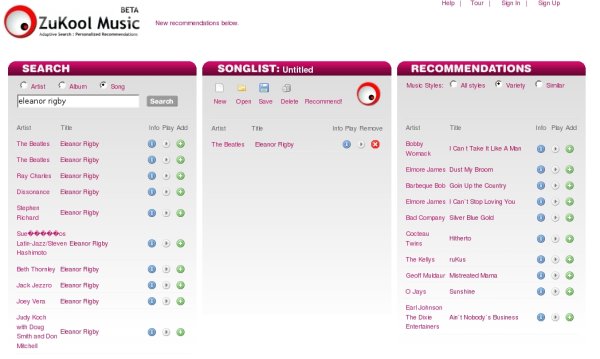
The User Interface
The
ZuKool user interface is well-designed and easy to use. One
really nice aspect is that there are no advertisements cluttering up the
interface. I had no problem figuring out how to use the system.
They use an appropriate amount of Ajax - the system felt very
interactive, with out lots of gratuitous (and CPU swallowing)
animations.
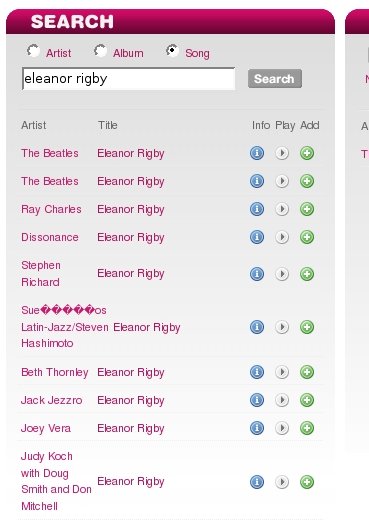
Using ZuKool is straightforward. Search for a an artist or song
that you like, add it to your Songlist, click the scary red eye and you
are given a set of songs that sound similar to your set of seed
songs. Along the way, you can listen to 30 second clips of the
songs (one glitch, the music didn't play on my linux box, but it worked
fine on my mac), get more info about a song, and even purchase the album
from Amazon or CD Baby.
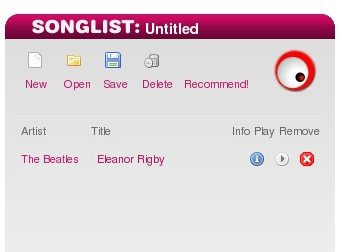
Although
ZuKool seems to have lots of music in its collection (they claim about
600,000 songs), the majority is not mainstream music - much of the music
looks to be from CDBaby.
The Recommendations:
The ZuKool recommenations were a bit hit or miss. I first tried the song Eleanor Rigby
by the Beatles. I was pleased to see a recommendation for a
Mozart String Quartet and a recommendation for the string-laden Taking my life in your hands
by Elvis Costello. Those are the types of recommendations that
highlight the strengths of a content-based recommender - they can
help you make serendipitous music discoveries by not following the
well-trodden path of the mob. However, we moved from the
serendipitous zone to the WTF zone pretty quickly. The rock anthem
Stairway to Heaven yielded the song from the original Cinderalla soundtrack A dream is a wish that your heart makes - and the Louis Armstrong classic "Jeepers Creepers". Jeepers Creepers indeed!
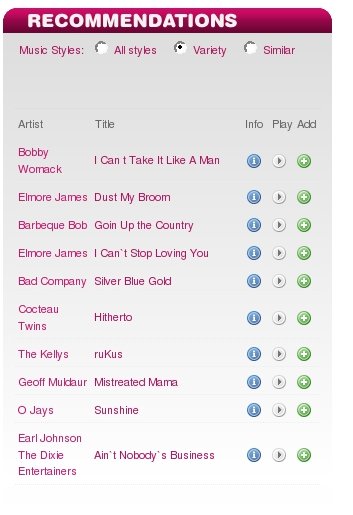
Obviously we still have a long way to go and many improvements to make. One major improvement coming soon is the ability to focus our initial recommendations based on your feedback (grading and additions to your songlist) which we have right now but is not yet operating to speed. We will also be adding user functions (social systems) to make the whole experience more community focused and fun.
Registrations for the 8th International
Conference on Music Information Retrieval, September 23rd - 27th 2007 in
Vienna, Austria, have just opened.
http://ismir2007.ismir.net/registration.html
More about the conference:
The 8th International Conference on Music Information Retrieval will be
held at the Vienna University of Technology in Vienna, Austria, from
Sunday, September 23rd to Thursday, September 27th, 2007. The annual
ISMIR Conference is the established international forum for those
working on accessing digital musical material. It reflects the
tremendous recent growth of available music-related data and the
consequent need to search within it to retrieve music and musical
information efficiently and effectively. These concerns are of interest
to academia, industry, entertainment, and education. ISMIR therefore
aims to provide a place for the exchange and discussion of news, issues,
and results, by bringing together researchers and developers, educators
and librarians, students and professional users, working in fields that
contribute to this multidisciplinary domain.
ISMIR 2007 will start with four Tutorials in specific domains on Sunday,
September 23rd, 2007:
The Technical Programme features plenary sessions with talks on
theoretical and practical work on Music Information Retrieval (MIR)
topics such as music analysis, segmentation and classification,
knowledge representation, MIR systems and interfaces, musicology, social
aspects and human factors. ISMIR 2007 received 214 submissions, of which
34 were accepted as long papers, 28 as short papers, and 67 as posters.
Each paper was reviewed by at least 3 reviewers and a meta-reviewer
(Programme Committee member). The full list of accepted papers is
available at: http://ismir2007.ismir.net/papers.html
The Technical Programme will be complemented by poster sessions which
give researchers an opportunity to present new work and ideas in an
interactive setting, as well as a dedicated session on MIREX, the 2007
Music Information Retrieval Evaluation eXchange.
The Social Programme of ISMIR 2007 will start with an Ice Breaking Event
after the Tutorials on Sunday, September 23rd. The official Reception
takes place at the Imperial Palace on Monday, September 24th and
includes a visit of the collection of ancient music instruments. The
Banquet will take place on Tuesday, September 25th at the City Hall of
Vienna.
The full programme of ISMIR 2007 will be available from July on:
http://ismir2007.ismir.net/program.html
Amazon, with its rich web services is one of the biggest providers of music metadata for music 2.0 companies. It is the largest source of album art for music 2.0. Soon, Amazon will be selling digital music - going head-to-head against the all powerful iTunes.
Amazon has a number of locations, one of the nicest is in the Pacmed building in Seattle.
Here's
an Amazonian office inside Pacmed - it looks like an enclosed office
(full height walls), a substantial whiteboard, some rather questionable
cable routing techniques, tiny speakers, and a Cuisinart! - everyone
needs a Cuisinart.
Another shared office at Amazon ... looks like it's nighttime, and this guy is not too happy, maybe its the poster behind him that is getting him down.
Now here's a much nicer looking office -- look at all of the big windows
And look at the view! You can't beat this view
A bit less glamorous for the interns though:
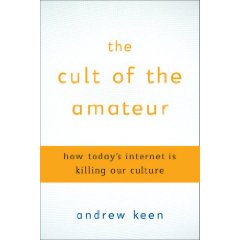 A new book has crawled onto my summer reading list: The Cult of the Amateur - how today's internet is killing our culture.
I heard an interesting interview with author Andrew Keen
about the book. He says that the vast amounts of
user-generated content is ruining our culture. I have a feeling I will
disagree with a lot of what he says. I'm not the only one.
Lawrence Lessig rips into it in his blog.
A new book has crawled onto my summer reading list: The Cult of the Amateur - how today's internet is killing our culture.
I heard an interesting interview with author Andrew Keen
about the book. He says that the vast amounts of
user-generated content is ruining our culture. I have a feeling I will
disagree with a lot of what he says. I'm not the only one.
Lawrence Lessig rips into it in his blog.
But what is puzzling about this book is that it purports to be a book attacking the sloppiness, error and ignorance of the Internet, yet it itself is shot through with sloppiness, error and ignorance. It tells us that without institutions, and standards, to signal what we can trust (like the institution (Doubleday) that decided to print his book), we won’t know what’s true and what’s false. But the book itself is riddled with falsity — from simple errors of fact, to gross misreadings of arguments, to the most basic errors of economics.
This blog copyright 2010 by plamere